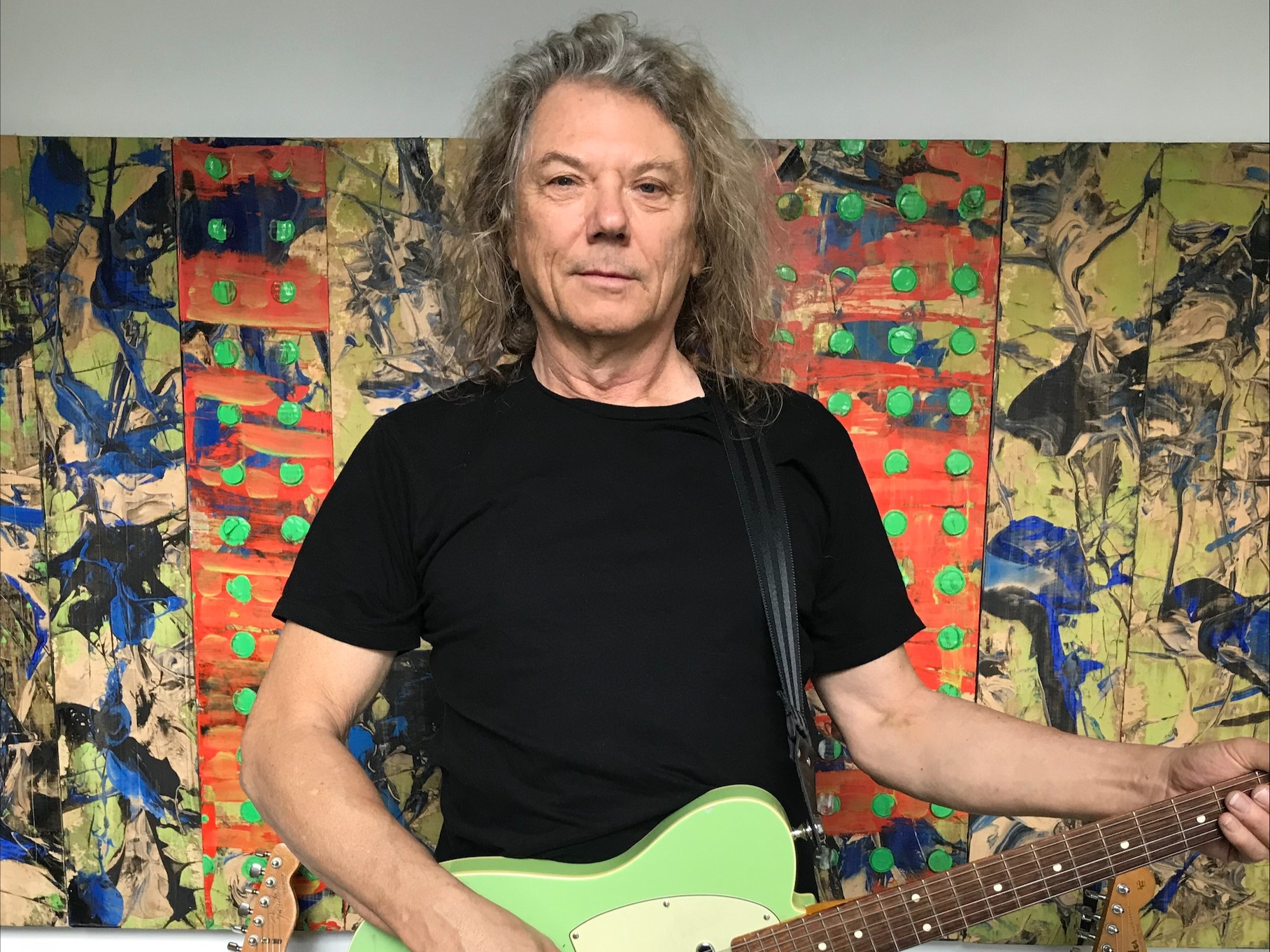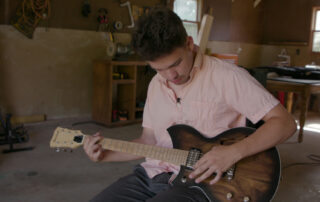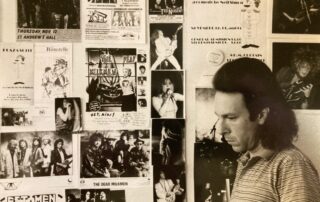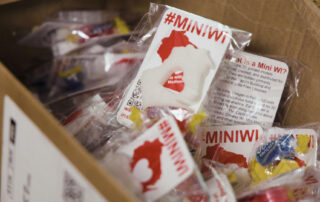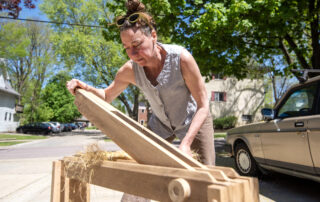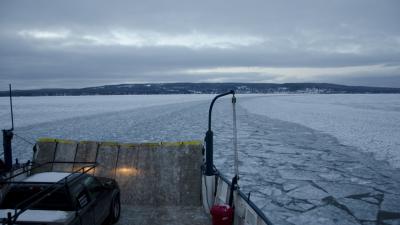“Stop Making Sense” has been hailed as one of the greatest concert films of all time. Directed by Jonathan Demme, the 1983 film unfolds as members of Talking Heads take the stage one by one. With each song, elements of the stage are added, dramatic lighting continually shifts the mood and David Byrne’s big suit steals the show. The film’s energy builds minute by minute, culminating in an explosive dance party. To this day, screenings of “Stop Making Sense” can pack theaters, where attendees often end up dancing in the aisles. Not only is the film considered a masterpiece, but Talking Heads have remained an iconic and influential band for decades. In 2002, they were inducted into the Rock & Roll Hall of Fame.
For one of the band’s core members — keyboardist, guitarist and vocalist Jerry Harrison — it all started in the Milwaukee area. He told the Milwaukee Journal Sentinel that he grew up in a musical home. While he was a student at Shorewood High School, Harrison played in the city’s thriving music scene as a keyboardist in The Walkers before he went off to Harvard College. That led to forming the Modern Lovers in 1970 with Jonathan Richman and eventually joining Talking Heads in 1977. Harrison has also had a successful career as a music producer, with 90s alternative bands like Live and No Doubt.
WPR “BETA” host Doug Gordon talked with Harrison in 2023 about the legacy of the Talking Heads and their iconic movie. Harrison will be hosting a screening of the recently restored movie in Madison on April 26 and in Milwaukee on April 27.
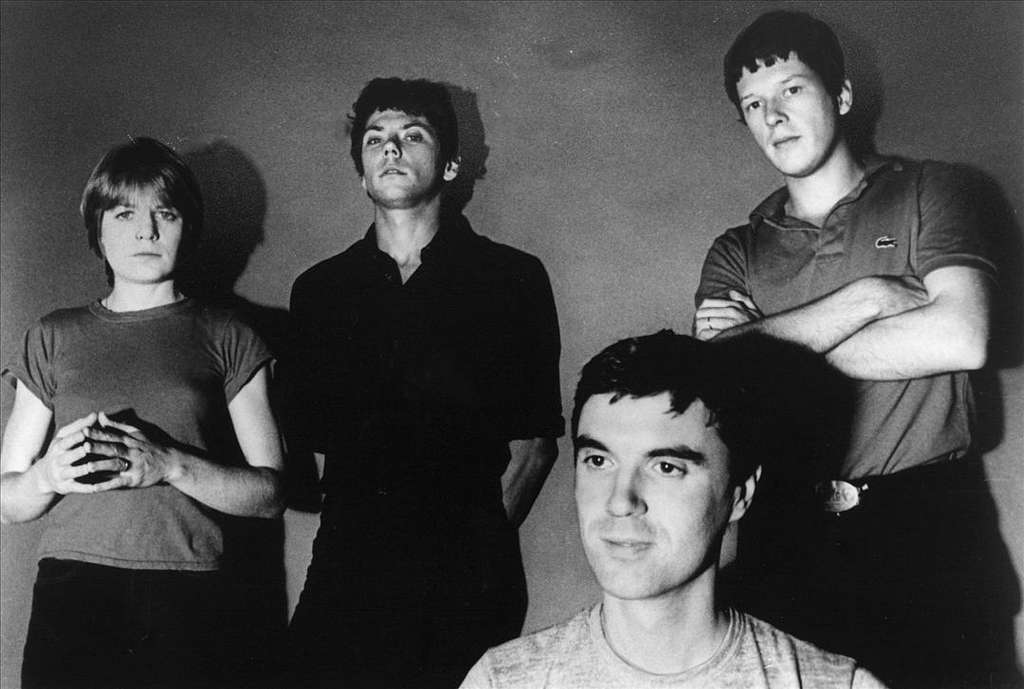
Musical group Talking Heads in a publicity photo from 1977. From left to right; Tina Weymouth, Jerry Harrison, David Byrne, and Chris Frantz. Photo courtesy of GetArchive
(This interview has been edited for brevity and clarity.)
Doug Gordon: Jerry, in 1974, you received a phone call from the Talking Heads drummer, Chris Franz. Can you tell us about this conversation?
Jerry: Chris called me up and said, “We’re looking for a keyboard player.” I had seen them in a place called The Club in Cambridge, Massachusetts. Then, they invited me to come down to New York to jam together. After the demise of the Modern Lovers, I was pretty broke. To get to New York, I helped [Modern Lovers bassist] Ernie [Brooks] move a family to New York in the band van. And when we got the van packed, there was no room for my organ.
So I showed up at the [Talking Heads’] loft with a guitar and they said, “Well, we’ve been looking for a keyboard player.” I said, “Oh, I know, I play keyboards, but there wasn’t room. But let’s just play some music.” It sounded great from the start.
Then, I came down and we did a show at the Lower Manhattan Ocean Club where they actually had a sax player play with us — another experiment they were thinking of. Then, we went out and played a show that was a private party in New Jersey, which is pictured on “The Name of This Band Is Talking Heads.”
Doug: What did you think of the Talking Heads when you jammed with them?
Jerry: I thought that there was nothing else in the world like them. It was really interesting and I really wanted to know more. When I played with them, the simpatico nature of it was that this seemed meant to be.
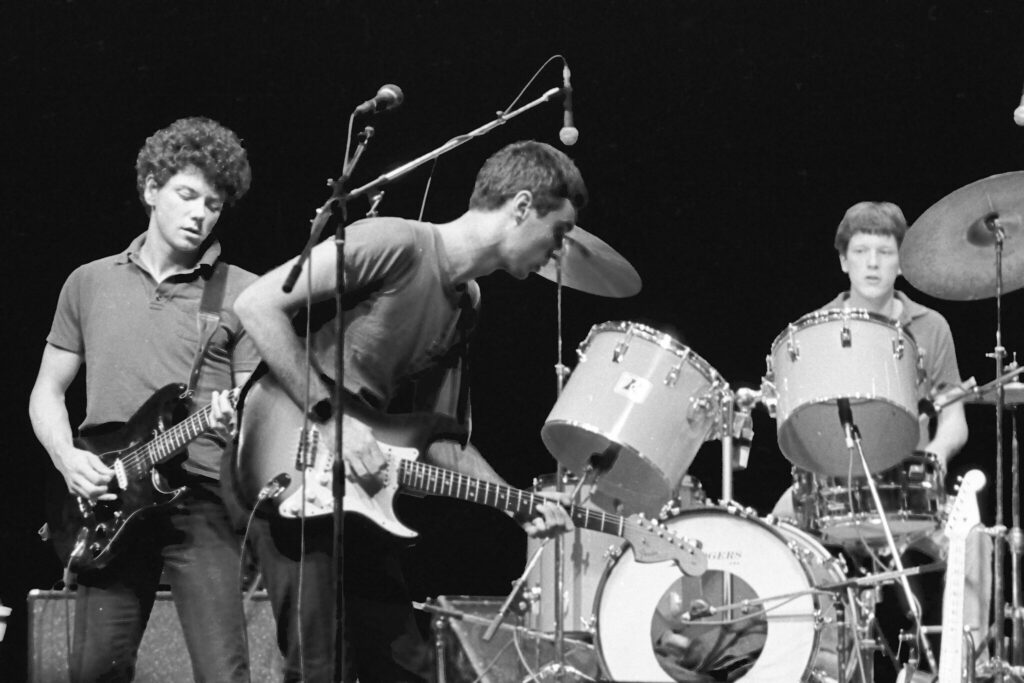
Talking Heads concert on Nov. 6, 1978 at Bowker Auditorium at UMass Amherst, Mass. From left to right: Jerry Harrison, David Byrne and Chris Frantz. Photo courtesy of Steve Garfield/Flickr
Doug: What do you think your work as guitarist, keyboard player and backing vocalist added to the sound of Talking Heads?
Jerry: When I joined the band, one of the biggest things I tried to do was to reinforce what they were already doing and not try to overly insert my personality into the band. I thought that what they were doing was already brilliant and wonderful. So, I just wanted to make it a little stronger, a little fuller. There were places where having another instrument could help smooth transitions between different sections of the song.
Doug: Do you have a favorite song that you think best reflects the contributions that you made to the sound of Talking Heads?
Jerry: I’d say “Take Me to the River” is a good one, because it’s dominated by the organ. If the organ weren’t there, it would be a very different song.
Doug: Let’s fast-forward to 1983. Talking Heads are touring to promote their fifth studio album, “Speaking in Tongues.” Then the band decides to shoot a concert film over the course of three nights at the Pantages Theatre in Hollywood. This led to the concert film “Stop Making Sense.” Who came up with this idea?
Jerry: We had been kicking around the idea of making a film. I think it’s important for everyone to understand that what is filmed is really what we did every night.
That being said, having the brilliance of Jordan Cronanweth as the [director of photography, or cinematographer], he spent a lot of time realizing that what the eye can deal with dynamic range, the camera can’t. So sometimes it was dimming some of the brighter lights and bringing up some of the dimmer lights to get the right balance. It was a lot closer to translating into what your eye is actually seeing. And then I think what [director] Jonathan [Demme] did is he understood that there was a built-in narrative to the film.
So, we were thinking about it. Jonathan and [producer] Gary Goetzman were a team and thought that our show would be a perfect one to film. By some fortuitous mutual friendships, we ended up meeting each other and he said, “I want to film this.” We thought, “Well, this is really great. We have somebody who has experience as a commercial film director.” We had been making videos, but this was somebody who understood the telling of the story and all these other things that you do in the longer format. That’s the film.
Doug: There are a number of fascinating things about “Stop Making Sense,” but one of the most fascinating things — in my opinion — is this idea of the band members coming out on stage one at a time. Whose idea was that and what did you think of that idea?
Jerry: The first time this band, the big [expanded Talking Heads] band played together, was at the Heatwave festival in Mosport Park in Canada. Now, this is the Remain In Light Band. So different personnel, Dolette McDonald is the singer. We have an extra bass player, Busta Jones, then we realized after that tour that we didn’t need two bass players. And then, of course, Adrian Belew, who was a very important part of that show. The [Remain In Light] show that Adrian and I have been doing — we actually played at Summerfest a few years ago . The 1980 concert in Rome is the inspiration for the tour that we are doing. So Talking Heads started that tour and the four of us came out and played. And then we said, “We’re not the same as we used to be,” and everybody else came out. So this sense that we went from simple to complex was already there.
And then David Byrne said, “How far can we take this?” So I would credit David. We did another tour after that “Remain In Light” tour … He goes, “Let’s see if we could build the band and build the stage at the same time.” Then he made storyboards for the whole thing. He worked with a talented lighting designer, Beverly Emmons, who had worked on [director and playwright] Robert Wilson’s productions, who’s perhaps most famous for [the avant-garde opera] “Einstein on the Beach.” David had been involved with the [Robert Wilson’s 12-hour opera] “Civil Wars.” His pieces are extremely long. And they very, very slowly change from this scene to another. They have a pace that’s from — let’s say — a more relaxed time period. So [David] was very influenced by some of those ideas that were around New York.
It was his idea to come and see how far we can take this. Can we build the stage? Can we go from one person to the entire band in succession? In some ways, people pointed out, it’s like David had done songs on his own, then [drummer] Chris Franz played with him. Then [bassist] Tina Weymouth joined — we, of course, reversed that in the film. Then I joined. And then the band got big. And the band got big because we had music that we couldn’t play with just a four piece.

Talking Heads members Bernie Worrell (l) on keyboards while Jerry Harrison plays guitar at a 1982 concert. Photo courtesy of Craig Howell/Flickr
Doug: What was it like playing with the expanded band lineup?
Jerry: It was wonderful.
First of all, they were all terrific musicians. I was the one who went out and hired the 1980 band, so I always felt that the band’s success was my success.
There were times when we gave some of the more fun parts to the additional players, so that they would feel excited and give it their all every night. If we would have given them the boring parts that needed to be there, I don’t think we would have got such great performances with them. We could all sit back and enjoy the success that the entire band had because that was our duty.
Doug: Do you have a favorite moment in “Stop Making Sense?”
Jerry: I have a favorite shot.
My favorite shot is when the distorted organ begins in “Once in a Lifetime.” The shot goes from David having been leaning back to [singers] Ednah Holt and Lynn Mabry leaning back and [keyboardist] Bernie Worrell and I are up there but the lighting is coming from below and they are rising up very slowly. I always call the shot “up from the crypt.” It’s got kind of a horror film look to it.
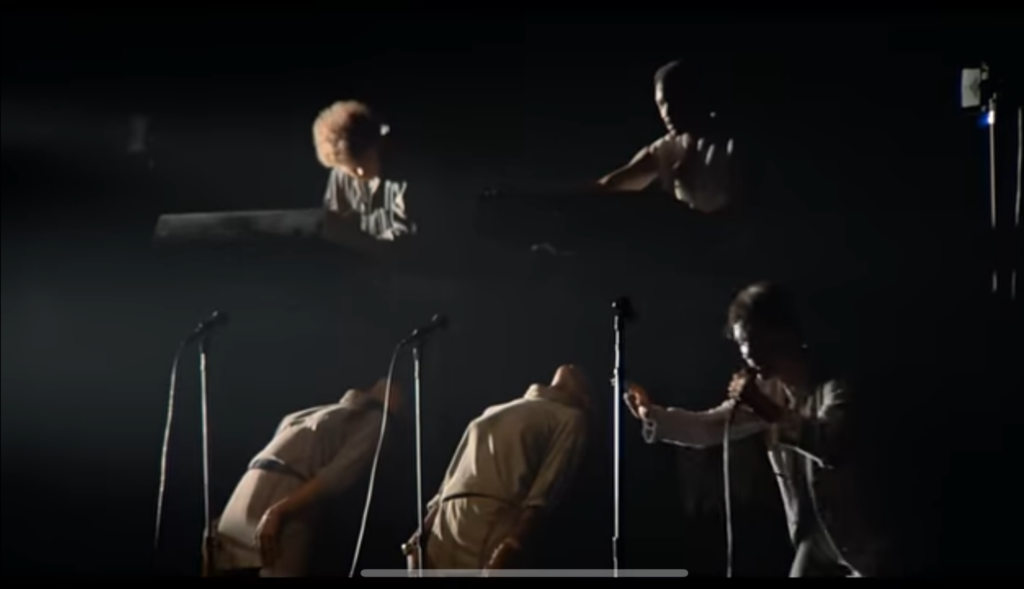
Jerry Harrison’s favorite shot from “Stop Making Sense,” It comes from the film’s A24 trailer
Doug: You said that you thought Talking Heads had the ability to become one of the biggest touring bands in the world at that time. How hard is it for you to deal with the fact that the band never toured again after “Stop Making Sense”?
Jerry: Well, I do think it’s a missed opportunity. I tried very hard to get the band to play Live Aid. I happened to be in London and I actually had the same offices where [Live Aid organizer] Bob Geldof was working the phones, trying to build the lineup. Bob and I were friends. I thought we would have torn it up. Also, we would have represented a little bit of men and women on stage, multiple races on stage. We sort of embodied this idea of the whole world being connected. So I think it was an unfortunate decision not to do that.
David was already heavily involved in getting his plans and the script ready for what became [the movie] “True Stories.” “Little Creatures” was an album that was really outtakes of the writing process for “True Stories,” interestingly. It’s such a good record, you wouldn’t think outtakes would be so good. They didn’t fit the storyline, but they were great songs.
I think that there were a lot of opportunities that we could have done. But I have pointed out that maybe I never would have had such a successful and diverse production career if Talking Heads weren’t working. I had already started producing by then, but I would’ve had to interrupt it. So maybe there would have been no “Throwing Copper” [by the band Live] had we continued. Life is funny this way. We make decisions and there are consequences, both good and bad, that happen to us.
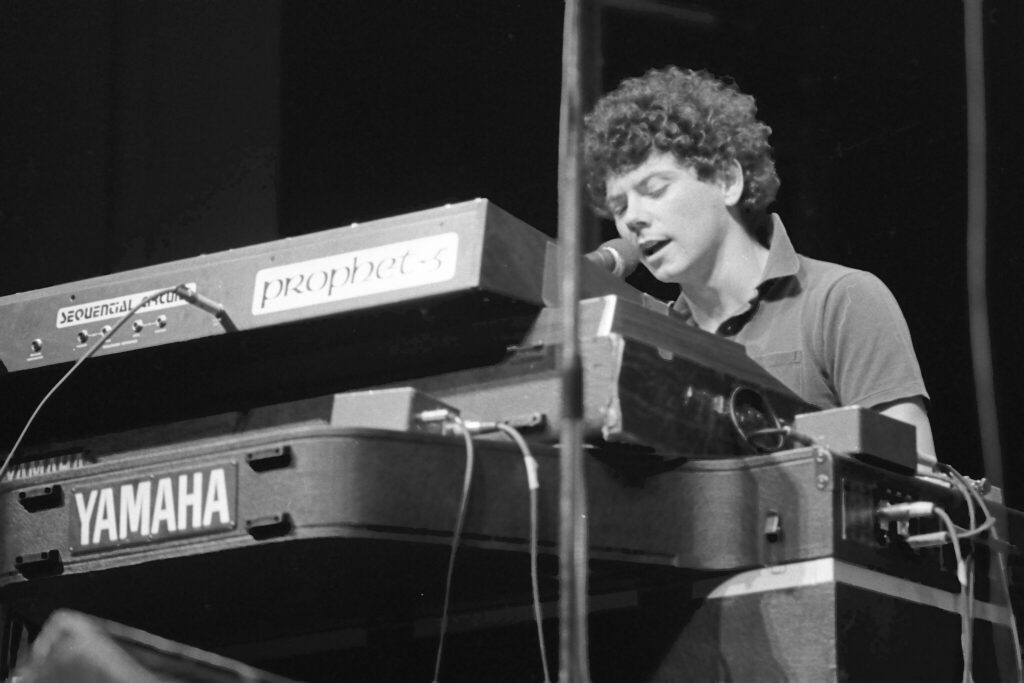
Jerry Harrison plays keyboards at a Talking Heads concert on November 6, 1978 at Bowker Auditorium at UMass Amherst, Mass. Photo courtesy of Steve Garfield/Flickr
Doug: We talked earlier about teaming up with guitarist Adrian Belew to revisit Talking Heads’ “Remain in Light” album live in several cities. Can you tell us a bit about that, why you wanted to do that and how it’s been going?
Jerry: Iit’s been going great. We’ve had just great reactions. We played for 55,000 people at Hardly Strictly [music festival], and there was a wave of joy that you could feel going out over the audience and then coming back. So it’s been very gratifying.
If you look at “Stop Making Sense,” there are only two songs from “Remain in Light” on it. There’s “Once in a Lifetime” and “Crosseyed and Painless.” And “Remain in Light” is such an essential, important part of the work of Talking Heads. And of course Adrian’s spectacular and fascinating guitar playing meant that that tour in 1980 was quite different than what “Stop Making Sense” was from the musical point of view, even though it had its similarities. I mean, it had [keyboardist] Bernie Worrell and it had Steve Scales on percussion and backing vocals and had background singers, but it still was quite different. It is more than “Stop Making Sense.” There were more things that we did as a big band that are really, really worthwhile and worth remembering and revisiting.
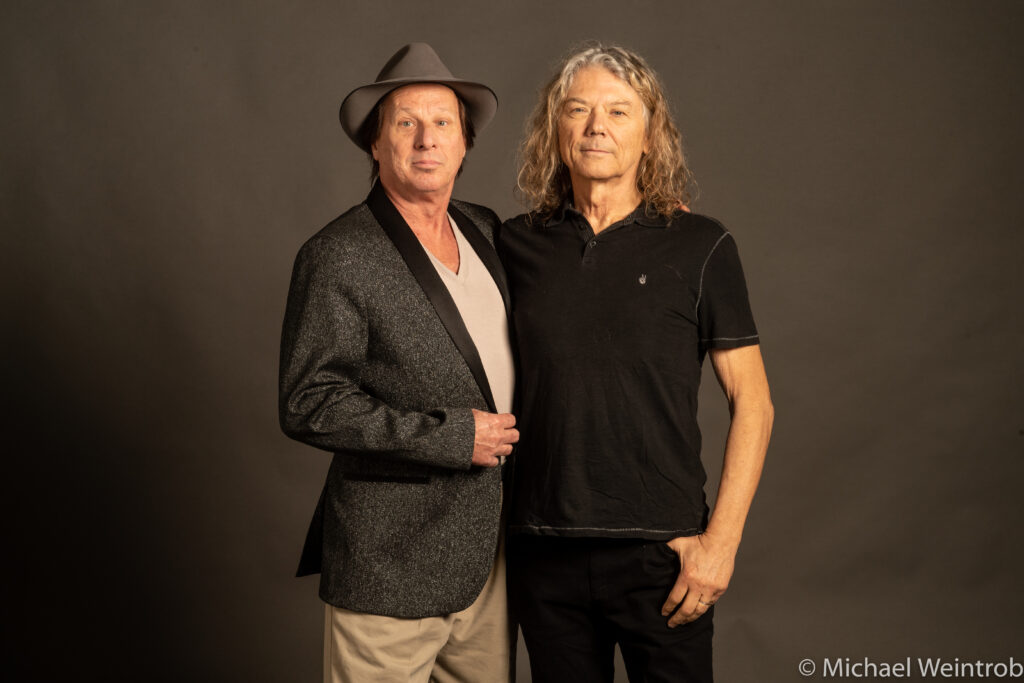
Musicians Adrian Belew and Jerry Harrison have been traveling the world with the “Remain In Light” tour, playing the influential 1980 Talking Heads album. Photo by Michael Weintrob
Doug: I’m curious about what’s next for you. You’re still touring with Adrian Belew. You’ve had such a rich career, there must be a few dream projects, things that you haven’t done yet but you still want to do?
Jerry: There are lots of people who I’d love to collaborate with.
Once I had the success with Live — which was such a tremendous success and those records were so good — I ended up sort of becoming one of the premier, at least for a period of time, alternative rock producers. There was the single, “New,” I did with No Doubt, a song [“Walking After You”] with the Foo Fighters, the Verve Pipe, other bands that fell into that genre.
But I never went back to working with the people that were the compatriots of the Talking Heads at that time. People like Peter Gabriel or Laurie Anderson … Also the bands that were somewhat influenced by us: LCD Soundsystem or Arcade Fire, something like that. All of those bands would have been wonderful challenges and a delight to work with.
